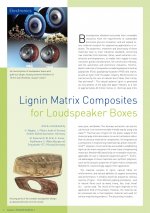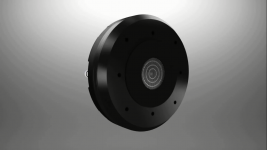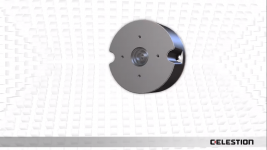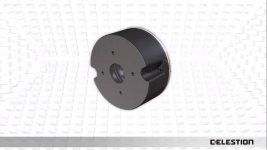Maybe docali can save in other formats as well, but this is a quick work-around.
This still leaves you with a model build up with faces (surface model) that needs to be converted to a solid body. I see docali has made some adjustments as it is almost a full closed model already with an outer back shell present this time around. With some patch work you should be able to convert it into a full solid. Pretty sure Youtube will have Tutorials on how to do that in Fusion 360.
A question though, did we start with a good match between the Axi and this horn? Do the angles (exit/entrance) match?
Actually, it becomes accidentially like a solid 😉 The goal was to merge the original SWH roll-back with the inner wall to reduce the footprint.
It could of course be saved in other formats or provided as point cloud.
Personally, I think this horn is way too large for most applications. I currently have no experiences simulation-wise with the progressive expansion. The goal was to reduce the length and get a better directivity control. There are many parameter combinations possible.
Concerning the drivers exit angle. If you one with an exit angle like 20 or 30 deg it may not be intended for such horns shown here. My 18s ND4015Be has an exit angle near zero and should work with nearly every horn.
@Camplo, The throat is often seen as the best thing to replicate with a 3d printer. It is small, critical and complex. I'd rather the throat be the part made by hand, also rear chamber and phase plug in the case of a lower frequency horn. This way it will be strong, immovable. There are many suitable materials. Lately I use aluminium billet, bored with hand formed profile, also acts as a driver mount and horn mount.
This is the type Don requested to see. An ellipse with lower cut-off and slight projection and progressive T:
View attachment drba_swh_300_sep_pe_rb.zip
nad here in obj format:
View attachment drba_swh_300_sep_pe_rb_obj.zip
View attachment drba_swh_300_sep_pe_rb.zip
nad here in obj format:
View attachment drba_swh_300_sep_pe_rb_obj.zip
Last edited:
@Camplo, The throat is often seen as the best thing to replicate with a 3d printer. It is small, critical and complex. I'd rather the throat be the part made by hand, also rear chamber and phase plug in the case of a lower frequency horn. This way it will be strong, immovable. There are many suitable materials. Lately I use aluminium billet, bored with hand formed profile, also acts as a driver mount and horn mount.
I am not sure we are talking about the same thing. I hope you know I am talking the throat of the horn not the compression driver. The Axidriver is throat-less I think!? So therefore 0 degree exit angle. I cannot find any information on such, and I'll probably have to call Celestion.
Personally, I think this horn is way too large for most applications. The goal was to reduce the length and get a better directivity control.
Reduce axial length and cutoff rises. Seems it's been posted earlier, but IME from reverse engineering some of the pioneer's horns to get adequate loading down to the XO point requires a nominally octave larger horn, so if 200 Hz XO is the goal, then a 1/2 WL axial length [~141 Hz] with a mouth perimeter ~1.5 octaves below 200 Hz [~71 Hz].
Also, earlier you mentioned 'progressive expansion T horns', what do you mean by this? It reminds me of a long ago [part of an] explanation of the 'T' factor where the mean between the hyperbolic to conical expansion was exponential, the rate of sound expansion, so curious how yours compares to it.
GM
Last edited:
I was not talking about the driver or its internals, only the horn proper. I only do phase plugs for lower range horns, and then only sometimes.
Oh, thats a new concept for me. Still wondering why 2 of us here are rooting for square horns. A round horn would have a more natural frequency response, would it not?
In theory. A square horn with the same mouth area = longer 'circumference' will close enough perform like a round one and a rectangular one has to have a < ~ 1:1.273 ratio.
GM
GM
Last edited:
I am not sure we are talking about the same thing. I hope you know I am talking the throat of the horn not the compression driver. The Axidriver is throat-less I think!? So therefore 0 degree exit angle. I cannot find any information on such, and I'll probably have to call Celestion.
The Axi2050 is a throat-less design. Should work well on most horns.
So what would be the this casting material that would produce this desireable product. Fiberglass/resin epoxy casts that are like autotech and Azurahorn, are acceptable but wood and concrete are better. The materials for such aren't expensive yet aren't cheap and involve multiple processes. Is there a sole material available that would also be desirable as a cast and finish process?
After decades of making waveguide I have found that glass filled polyurethane is by far the best material. I once tried to break one of my waveguide with a hammer - no luck. I took a sledge hammer to it and it finally cracked, but did not break apart. It is also extremely well damped, but alas rather expensive. But you get what you pay for. Does require a moutnig plate for the driver however.
Reduce axial length and cutoff rises. M
I don't think that this is true, in theory its not.
In theory. A square horn with the same mouth area = longer 'circumference' will close enough perform like a round one
I don't see this as a relevant factor, but sure a square one will approach a round one as its shape gets closer to round, but the round will always be better or at least as good. I have never seen any rational for a square device being better than round. Ellipse has some appeal, but is much harder to fabricate. A round waveguide is very easy to make - nothing beats it for ease of construction versus performance.
Reduce axial length and cutoff rises. Seems it's been posted earlier, but IME from reverse engineering some of the pioneer's horns to get adequate loading down to the XO point requires a nominally octave larger horn, so if 200 Hz XO is the goal, then a 1/2 WL axial length [~141 Hz] with a mouth perimeter ~1.5 octaves below 200 Hz [~71 Hz].
Also, earlier you mentioned 'progressive expansion T horns', what do you mean by this? It reminds me of a long ago [part of an] explanation of the 'T' factor where the mean between the hyperbolic to conical expansion was exponential, the rate of sound expansion, so curious how yours compares to it.
GM
Of course, this is the trade-off if you reduce the length. camplo's x-over target point is very challenging. For the faster opening horns the x-over point need to be set higher.
If you choose as horn expansion formula for an hyperbolic horn:
S = S_0 * (Cosh(m * x / 2) + T * Sinh(m * x / 2)) ^ 2
and set T=1 you get exactly the spherical wave horn formula. For JMLC horns most prefer T=0.707. But this increases the length of the horn. Some secrets need to be kept but if you find an appropriate function that increase T along the horn axis then you receive a more and more faster opening horn. And only if you choose an assumed wave front for S you get a roll-back. The idea of faster opening horn against a certain constraint of target point is already very old. I think Manfred Harsdorf were one of the first who filed a patent about this a long long time ago.
I recall reading lots about an on-axis dip of round OS waveguides. I remember that coming up in discussions from time to time when a round OS type waveguide was compared to the Seos. I know Dr. Geddes prefers to use an off axis design axis. But for camplo here I think he'd want on axis performance with his wish to use a 2 way and more specifically use the horn over a very wide frequency range.
Would a rounded square or elliptical shaped horn help camplo's desires to cover such a wide bandwidth? That would be my question. Which is better for that specific task.
I know most would say to change that wide band frequency goal, but hey, this is what camplo would like to try (and find out). He found a seemingly suitable driver, capable of doing just that in the Axi.
Would a rounded square or elliptical shaped horn help camplo's desires to cover such a wide bandwidth? That would be my question. Which is better for that specific task.
I know most would say to change that wide band frequency goal, but hey, this is what camplo would like to try (and find out). He found a seemingly suitable driver, capable of doing just that in the Axi.
Oh, thats a new concept for me. Still wondering why 2 of us here are rooting for square horns. A round horn would have a more natural frequency response, would it not?
Take a look at the old and big cinema horns. Most of them have a squared shape. Maybe there was practical reason for that (transport, manufacturing, etc.). I would prefer an elliptical shape but I also have to admit that it would be more complicated to produce.
Its funny you should say that, my engineering buddy thinks the same thing. To create a mold using 3d printing and then use soem type of material to create a cast. I'm not against that but, I'd be fully convinced if the end result was cheap and desirable.
I also have an engineering background, so that makes sense to me 🙂. I'd simply would want to use better or more suitable materials than filament printing could provide. But 3D printing can still be of help to create something in different materials. Covering the printed plastics in epoxy would need testing too. Epoxy and plastic isn't always a sticky partnership. In fact some types of plastics are often used because it does not adhere to epoxy at all.
Some more inspiration:
Did you see the the personal web page from Bjørn Kolbrek? On it is his own system (at least up till january 2018) and the journey he made to create his own 200 Hz midrange horns (DIY).
Among other things he used a casting process for the horn throat which is described here: Exponential Midrange 2
On another note, if you do end up wanting to make round horns you might want to look into the Delta type 3D printers. They do round shapes rather good and are quite scalable.
Last edited:
Left: 4015Be, throatless, as confirmed by 18Sound
Right: Axi2050, you'd think it's also throatless.
Right: Axi2050, you'd think it's also throatless.
Attachments
Last edited:
100% throatless implies all phaseplug channels end at the exit, like the 18Sound 4015 and JBL 2451.
My B&C drivers are flat like a typical pancake driver, but aren't throatless (exit angle = 34.7°).
100% throatless implies a 0° angle.
I'll send a request to Celestion's Doc. about the Axi's exit angle.
My B&C drivers are flat like a typical pancake driver, but aren't throatless (exit angle = 34.7°).
100% throatless implies a 0° angle.
I'll send a request to Celestion's Doc. about the Axi's exit angle.
Last edited:
Take a look at the old and big cinema horns. Most of them have a squared shape. Maybe there was practical reason for that (transport, manufacturing, etc.). I would prefer an elliptical shape but I also have to admit that it would be more complicated to produce.
Rectangular throats were primarily chosen for their dispersion (wide coverage was needed for the large theaters), but also because these were easier to manufacture.
But for camplo here I think he'd want on axis performance with his wish to use a 2 way and more specifically use the horn over a very wide frequency range.
Would a rounded square or elliptical shaped horn help camplo's desires to cover such a wide bandwidth? That would be my question. Which is better for that specific task.
I know most would say to change that wide band frequency goal, but hey, this is what camplo would like to try (and find out). He found a seemingly suitable driver, capable of doing just that in the Axi.
If a (very) narrow sweet spot isn't prohibitive, it doesn't really matter much whether you opt for a round or elliptical mouth, even more so with deep horns and larger driver exit sizes (2"), as the beaming >8Khz will be similar for both designs.
An elliptical mouth is effective for 'smaller bandwith' waveguides in which the wavefront 'sees' the walls over a large(r) part of the intended usable bandwith. The extent to which this is the case (also) depends on the throat section. A slotted throat helps a lot in this regard. Theoretically, an OS throat is a kind of 'slot', even though I expect Dr. Geddes to disagree.
Last edited:
- Home
- Loudspeakers
- Multi-Way
- Is it possible to cover the whole spectrum, high SPL, low distortion with a 2-way?




